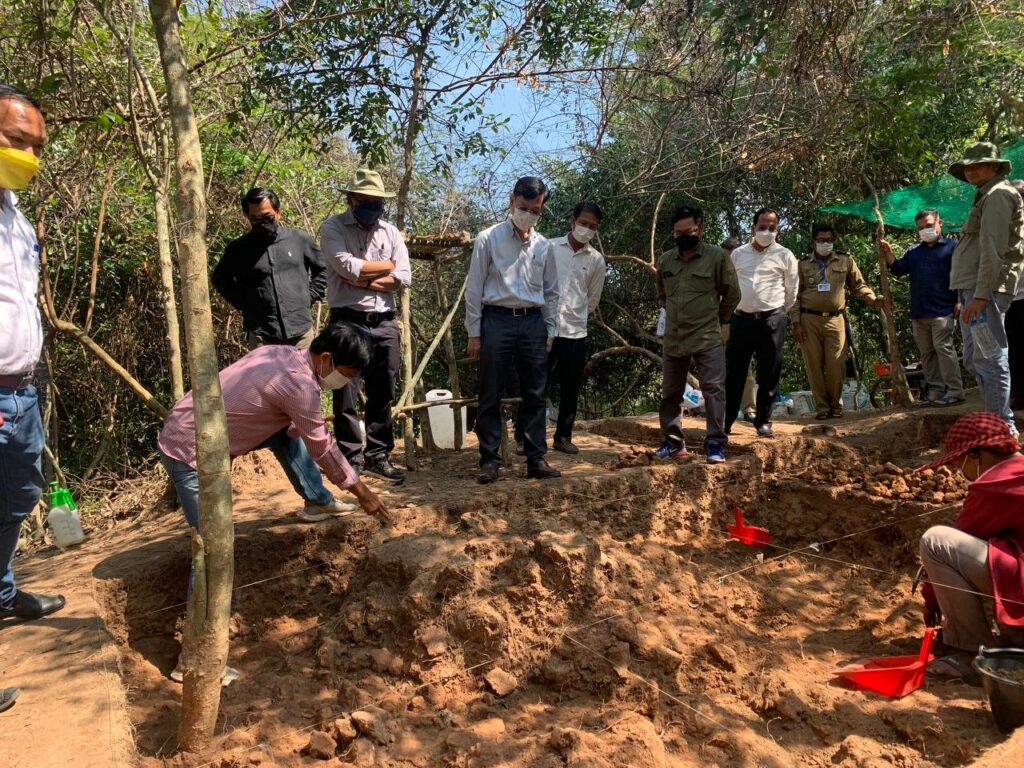ក្រុមបុរាណវិទ្យានៃមជ្ឈមណ្ឌលអន្ដរជាតិស្រាវជ្រាវ និងតម្កល់ឯកសារអង្គរនៃអាជ្ញាធរជាតិអប្សរា បានបន្តការសិក្សា និងបញ្ចប់ការធ្វើកំណាយស្រាវជ្រាវឡដុតភាជន៍ប្រើប្រាស់ប្រចំាថ្ងៃ នៃសហគមន៍ស្មូនបុរាណនៅឡទ្វារដីឆ្នាំងនៃក្រុងអង្គរធំ។
លោក ទិន ទីណា អនុប្រធានទទួលបន្ទុករួមមជ្ឈមណ្ឌលអន្ដរជាតិស្រាវជ្រាវ និងតម្កល់ឯកសារអង្គរនៃអាជ្ញាធរជាតិអប្សរា មានប្រសាសន៍ថា កាលពីចុងឆ្នាំ២០១៩កន្លងទៅ ក្រុមការងារមជ្ឈមណ្ឌលអន្ដរជាតិស្រាវជ្រាវ និងតម្កល់ឯកសារអង្គរបានធ្វើកំណាយនៅទួលត្រពាំងបុស្ស ក្នុងគោលបំណងបញ្ជាក់ឱ្យច្បាស់ថាទួលនេះជាឡដុតភាជន៍សម័យបុរាណឬយ៉ាងណា? តាមរយៈលទ្ធផលកំណាយ ក្រុមការងារបានរកឃើញរចនាសម្ពន្ធឡដុតភាជន៍ក្នុងសីតុណ្ហភាពទាប ដូចជា ឆ្នាំង ក្អម ក្រឡ និងក្បឿង។ល។ លោកបានបន្តទៀតថា យោងលើលទ្ធផលស្រាវជ្រាវ ដែលជាមូលដ្ឋានទិន្នន័យមួយយ៉ាងសំខាន់ដែលអាចបញ្ជាក់បានថា នៅលើទំនប់ស្ថិតនៅជ្រុងភាគពាយព្យខ្លោងទ្វារដីឆ្នាំងនៃក្រុងអង្គរធំ មានឡដុតភាជន៍សម័យបុរាណពិតប្រាកដមែន ដូច្នេះហើយទើបក្រុមការងារមជ្ឈមណ្ឌលអន្តរជាតិស្រាវជ្រាវ និងតម្កល់ឯកសារអង្គរ បានបន្តស្រង់ទិន្នន័យបណ្តុំឡដុតភាជន៍ និងបោះបង្គោលប្រថពីវិភាគនៃនិយាមភូមិសាស្ត្រ (G.P.S) នៅទីតាំងទ្បទ្វារដីឆ្នាំងនៃក្រុងអង្គរធំដើម្បីកំណត់ពីវិសាលភាពស្ថានីយ កំណត់ចំនួនទួលទ្ប និងបែងចែកក្រុមទួលឡ។ល។ ជាលទ្ធផលយើងអាចកំណត់បានថា បណ្តុំទួលឡដុតភាជន៍នៅក្រុមឡទ្វារដីឆ្នាំងនៃអង្គរធំ មានទួលឡសរុបចំនួន២៤ និងចែកចេញជា១១ក្រុម។
លោកបន្តថា តាំងពីដើមខែកុម្ភៈ ឆ្នាំ២០២២មក ក្រុមការងារបានជ្រើសយកទួលមានលេខសម្គាល់ TDCK7a ក្នុងក្រុមទី៧ ដើម្បីធ្វើកំណាយស្រាវជ្រាវ។ គោលគំនិតនៃការធ្វើកំណាយស្រាវជ្រាវទួលឡនេះ គឺដើម្បីសិក្សាបន្ថែមពីរចនាសម្ព័ន្ធឡផ្សេងៗទៀត នៅក្នុងបរិវេណឡទ្វារដីឆ្នាំង ថាតើមានទម្រង់ដូចឡ TDCK1 (ទួលត្រពាំងបុស្ស) ដែរឬទេ និងដើម្បីស្វែងយល់ពីការប្រាស័យទាក់ទងគ្នារបស់ក្រុមស្មូននៅទ្បទ្វារដីឆ្នាំង។
លោកបន្តថា រហូតមកដល់ពាក់កណ្តាលខែមីនា ឆ្នាំ២០២២នេះ ជាលទ្ធផលនៃកំណាយស្រាវជ្រាវ បានរកឃើញសំណល់រចនាសម្ពន្ធឡដុតភាជន៍ ដែលមានរចនាសម្ពន្ធដូចគ្នាទៅនិងឡ TDCK1 ប៉ុន្តែមានលក្ខណៈខុសប្លែកត្រង់ថា នៅលើនៅទួល TDCK1 មានឡតែមួយ ចំណែកឡនៅលើទួល TDCK7a រកឃើញមានឡចំនួន៤ មានចរន្តភ្លើងរត់ពីក្រោមឡើងទៅលើដូចចង្រ្កាន ហើយយោងតាមលទ្ធផលស្រាវបញ្ជាក់ថា ឡទាំងនោះចំនួន២ឬ៣អាចដុតដំណាលគ្នាក្នុងពេលតែមួយ។
លោក ឆាយ រចនា ប្រធានការិយាល័យសិក្សាកុលាលភាជន៍អង្គរនៃមជ្ឈមណ្ឌលស្រាវជ្រាវអន្តរជាតិ និងតម្កល់ឯកសារអង្គរបានឱ្យដឹងថា ក្នុងចំណោម ឡដុតកុលាលភាជន៍ទាំង៤ នៅទួល TDCK7a នេះ មិនមែនមានទំហំធំទាំងអស់ទេ ដោយឡខ្លះ មានអង្កត់ផ្ចិតកម្ពស់ត្រឹមតែ១ម៉ែត្រកន្លះ និងខ្លះទៀតមានទំហំដូចគ្នានិងឡនៅទួល TDCK1 មានប្រវែងមុខកាត់២ម៉ែត្រ២តឹក និងបណ្ដោយ៣ម៉ែត្រ។ ដែលអាចសន្និដ្ឋានបានថា ជារចនាសម្ព័ន្ធឡបុរាណមួយ ដែលចាប់ផ្តើមផលិតកុលាលភាជន៍នៅចុងសតវត្សរ៍ទី១៣ និងបញ្ចប់នៅដើមសតវត្សរ៍ទី១៥៕
អត្ថបទ៖នាយកដ្ឋានផ្សព្វផ្សាយ
រូបភាព៖មជ្ឈមណ្ឌលអន្ដរជាតិស្រាវជ្រាវ និងតម្កល់ឯកសារអង្គរ
APSARA National Authority completes excavation of the ceramic kiln site (TDCK7a) at Dei Chhnang Gate of Angkor Thom
The archeological team of the Angkor International Center of research and documentation of APSARA National Authority continues to study and completes the excavation of the site of the ceramic kilns at Dei Chhnang Gate of Angkor Thom.
Mr. Tin Tina, Deputy director of the Angkor International Center of research and documentation, said that in late 2019, his team excavated on an ancient mound called Tuol Trapeang Bos to confirm if that mound was an ancient ceramic kiln. Through the excavation results, the team found the structure of the low-temperature kiln, which was used for ceramic production such as pots, water jars, and tiles. He added that according to the research results, which is an important database that can confirm that there were the ceramic kilns on the dam in the northwest corner of the Dei Chhnang Gate of Angkor Thom, that is why the working team of the Angkor International Center of research and documentation continues to collect data on pottery clusters and post-analysis of GPS at the site of the ceramic kilns of Dei Chhnang Gate of Angkor Thom to determine the scope of the site, determine the number of mounds and divide the group of the mounds. As a result, we can determine that the ceramic kilns at Dei Chhnang Gate of Angkor Thom have a total of 24 kilns and are divided into 11 groups.
Mr. Tina said that since the beginning of February 2022, the team has selected TDCK7a in group 7 for excavation. The concept of kiln excavation is to learn more about the structure of other kilns in this area, whether it is similar to the TDCK1 (Tuol Trapeang Bos) kiln, and to understand the kiln group connection at this site.
He added that until mid-March 2022, as a result of excavations, the remains of the kiln structure were found to have the same structure as the TDCK1 kiln, but with the difference that on the TDCK1 mound, there was only one kiln. On the other hand, on the TDCK7a, there are four kilns and according to the research results, two or three kilns can burn at the same time.
Mr. Chhay Rachana, head of the ceramic study office of the Angkor International Center of research and documentation, said that of the four ceramic kilns at TDCK7a, not all were large, some were just 1.5 meters in diameter and some are the same sizes as the kiln at TDCK1 with a diameter of 2.2 meters, and a length of 3 meters. It can be concluded that it is an ancient kiln structure that started to produce ceramics in the late 13th century and ended in the early 15th century.
Article: Department of Communication
Photo: Angkor International Center of research and documentation
21 March 2022





